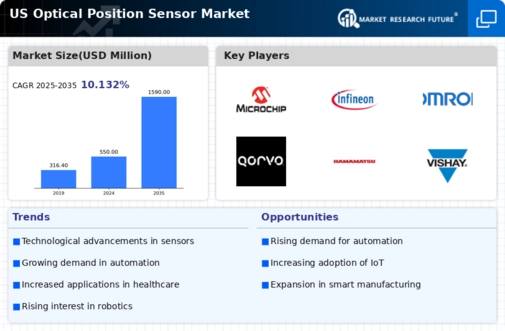Growth in Robotics and Automation
The optical position-sensor market is poised for growth due to the expanding robotics and automation sectors. As industries strive for greater efficiency and productivity, the integration of optical position sensors in robotic systems is becoming more prevalent. These sensors provide critical feedback for precise positioning and movement control, which is essential for applications ranging from manufacturing to logistics. The market for industrial robots alone is projected to exceed $20 billion by 2025, indicating a robust demand for optical position sensors. This trend suggests that as automation continues to evolve, the optical position-sensor market will likely benefit from increased adoption across various industries.
Rising Demand for Precision Engineering
The optical position-sensor market is experiencing a notable surge in demand driven by the increasing need for precision engineering across various sectors. Industries such as aerospace, robotics, and medical devices are prioritizing accuracy and reliability in their operations. This trend is reflected in the projected growth of the market, which is expected to reach approximately $1.5 billion by 2026, with a CAGR of around 8% from 2021 to 2026. As manufacturers seek to enhance their product quality and operational efficiency, the adoption of optical position sensors becomes essential. The ability of these sensors to provide high-resolution measurements and real-time feedback positions them as a critical component in modern engineering applications, thereby propelling the optical position-sensor market forward.
Increased Focus on Safety and Compliance
Increased focus on safety and compliance regulations is driving the optical position-sensor market. Industries such as automotive, aerospace, and manufacturing are under pressure to adhere to stringent safety standards, which necessitates the use of reliable sensing technologies. Optical position sensors are crucial for ensuring that machinery operates within safe parameters, thereby reducing the risk of accidents and enhancing overall workplace safety. The market is projected to grow as companies prioritize compliance with safety regulations. An estimated increase of 6% in demand for optical position sensors is expected over the next few years. This trend indicates that the optical position-sensor market will continue to expand as safety becomes a central concern for various industries.
Emergence of Smart Manufacturing Practices
The emergence of smart manufacturing practices is a key driver for the optical position-sensor market. As manufacturers adopt Industry 4.0 principles, the need for real-time data and precise control systems becomes paramount. Optical position sensors play a vital role in enabling smart factories by providing accurate positioning data that enhances machine performance and reduces downtime. The market is expected to witness a growth rate of approximately 9% annually as more companies invest in automation technologies. This shift towards interconnected systems and data-driven decision-making is likely to create new opportunities for the optical position-sensor market, as these sensors are integral to achieving operational excellence.
Technological Advancements in Sensor Design
Technological advancements in sensor design are significantly influencing the optical position-sensor market. Innovations such as miniaturization, improved sensitivity, and enhanced durability are making these sensors more appealing to a broader range of applications. For instance, the introduction of MEMS (Micro-Electro-Mechanical Systems) technology has enabled the development of compact and highly efficient optical sensors. This evolution is likely to attract investments, with the market projected to grow at a CAGR of 7.5% over the next five years. As industries increasingly adopt smart technologies, the demand for advanced optical position sensors that can seamlessly integrate into existing systems is expected to rise, further driving the growth of the optical position-sensor market.






















Leave a Comment